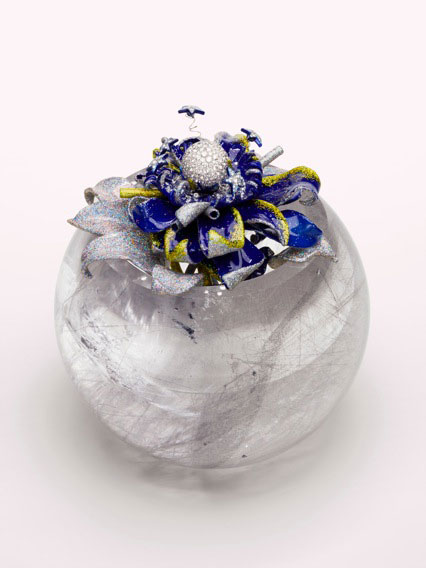
With base: 5 7/8” x 5”. Photo courtesy Gagosian Gallery & Victoire de Castellane
The display is bare enough. Four whitewashed tables occupy, but do not crowd, Gagosian’s second floor ‘project space.’ Two or three pieces mushroom on each one: they are encapsulated under glass domes and are either discreetly top lit or bask in the suffused light of a dedicated built-in light box. If the domes are meant to evoke cabinets of curiosity, as suggested to me by the gallery clerk, they fail to do so. This scenographic shorthand is all but ubiquitous these days in Paris jewelry boutiques and is gradually losing whatever connection it once had with the accumulation of unclassified artifacts by the deep-pocketed social elite of the late renaissance. Thanks to the gallery’s otherwise empty white space, the overall effect is crisp and, were it not for the irregular placement of the minimal tables, might evoke a lab or, possibly, a high-power American gallery’s ‘project space.’


Castellane’s fearless use of bright colors on gold is part of her subversive appeal in the conservative world of French luxury jewelry. One would have to start from ‘gaudy’ and work up a new lexicon to do justice to the toxic splashes of her fermenting microfollies. What the pieces lack in scale, they make up for with an overabundance of formal twists and colorful turns, born of excessive craftsmanship. The extensive use of lacquers, matt or gloss, sparkles, real or fake, texture, grainy, veinous, crinkled, on the clenched folds of her vegetation keeps the eye in a perpetual state of gasp. It fascinates and petrifies, as only such a concentration of effects can. It is, in short, spectacular craft.
Is this the reason she is shown at Gagosian? Certainly the exhibition holds its own – does very well, in fact – compared to the Sugimoto photographs shown in the main gallery. Nor is it the outcome of a behind-the-scene alliance between contemporary art’s finest and fashion royalty (read Dior and behind it, the luxury behemoth that is LVMH). Castellane funded the show herself, thus sidestepping the danger of having it dismissed as a vanity stunt.

These are not criteria usually applied to contemporary art. They come from traditional craft and defined the rules of engagement between the bigger luxury houses until the 1930s. In fact, the glass domes, the white tables, the tall reception desk, do not really erase the show’s affiliation to haute-craft, nor do they manage to blur the distinction between craft and art. There is a discursive attempt to do so, however, and the main casualty, on the craft side, is wearability. I was informed at the desk that buyers were collectors from the art world, rather than the fashion or luxury world and that the pieces were pointedly ‘not necessarily meant to be put on.’ This strategy echoes recent development in contemporary jewelry and assumes that function weakens the work’s bid for respectability. It encourages the production of a new typology of objects: predicated on use (a ring, a necklace, a bracelet; objects for the body) they must remain unused to deploy their weird kind of magic.





